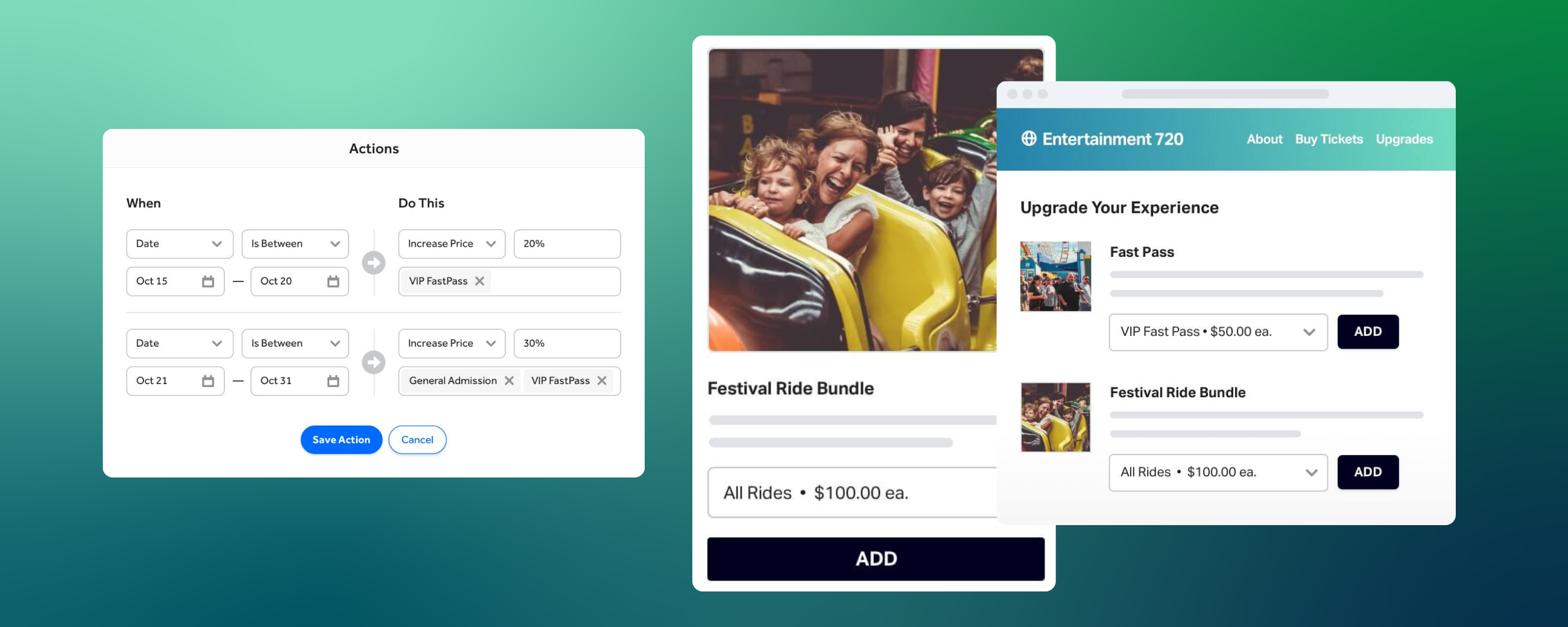Dynamic Ticket Pricing: How To Utilize It
Event pricing is rarely a one-size-fits-all kind of equation. If you only offer one fixed price, you’re probably leaving money on the table and attendees out of the event. Dynamic ticket pricing is a game-changer in the event space. Ticket levels and VIP stamps are not the only variables that give you leverage to raise your rates either. Dynamic ticket pricing gives you the freedom to charge based on ticket levers, date windows, time of day or ticket demand.
In the rest of this article, we'll explore different types of dynamic ticket pricing, how they work, best practices, pros and cons, and key takeaways to help you make informed decisions for your events.
What is Dynamic Ticket Pricing?
In a traditional fixed pricing model, there is one price for all attendees. It doesn’t matter if you attend the haunt at noon on Sunday or 8 pm on Friday, the price is the same.
Dynamic Ticket Pricing, on the other hand, is a ticket pricing strategy where ticket prices fluctuate based on various factors such as demand, time, date, or even specific attendee details like local residents or senior citizens. Adjusting ticket prices according to these factors helps maximize revenue and optimize attendance.
How Does Dynamic Ticket Pricing Work?
Dynamic pricing relies on data analytics and algorithms to determine the optimal ticket prices. Factors like historical sales data, current demand, competitor pricing, and external events are all taken into account to set the various price points. This real-time adjustment ensures that ticket prices accurately reflect market conditions and attendee preferences.
Types of Dynamic Ticket Pricing
There are a number of different ways to succeed with dynamic ticket pricing. We breakdown the specifics of a few of the common price variables below.
Time of Day
Many events have a natural ebb and flow of people where the peaks are highly correlated to certain popular times of day. Berry-picking farms, for example, see far more crowds in the morning while the berries are fresh and the weather is cool, whereas haunted houses attract more people in the dark and spooky nighttime hours.
If your event has clear crowd surge hours, you can charge a higher rate for the peak and a discount for the unpopular times. Those who absolutely must see the haunt on Friday night will pay the higher price. Other attendees, such as younger families, will gladly accept discounted tickets to a 4:00 pm haunt.
Bonus: The Power Hour
If your event involves picking something—like strawberries or flowers—arriving late could mean missing the harvest. That said, it doesn’t have to mean missing the fun.
You can offer a steeply discounted “power hour” ticket for the late afternoon. Even if it doesn’t include the berries, kids will still have a blast jumping around in the bounce house while the adults get a buzz at the beer garden.
Day of the Week
Does your event look like a mob on weekends and a ghost town on weekdays? If so, base your price on the demand of the day. In a nutshell, demand will drive the peak-day purchases, whereas incentive will drive the off-peak-day purchases.
Since weekends tend to see higher volumes of crowds, charge a higher rate (10%+) for Saturday and Sunday tickets and offer a discount for weekdays.
If your event is Holiday specific, you can also charge more for those coveted day-of tickets. Dialing in your demand day pricing, will help ensure your haunted house event never feels like a ghost town—even if it is full of ghosts.
Demand Based Pricing
With the demand-based strategy, you use the number of tickets remaining to incentivize purchasing. As the ticket inventory goes down, the price goes up along with the demand. For example, maybe the first 50 concert tickets are 20% off, the next 50 tickets are 10% off, and after that, it’s general admission. However you set up the actions, the prices fluctuate according to the level of demand.
While it’s true that people procrastinate, they tend to procrastinate less when money is on the line. Feel free to post the inventory price tiers on your website to incentivize even further.
Ticket Levels
When people think of dynamic pricing, ticket levels or segmented pricing are often what comes to mind. Provide several different offerings at various price points to appeal to a broader range of attendees. These price tiers can be based on attendee demographics, preferences, or purchasing behavior. Perhaps it’s a VIP experience at the concert or an unlimited drinks pass at the festival. Custom-branded ticketing pages can further enhance these offerings by aligning the experience with your event’s identity. You’ll benefit from the increased inventory, and attendees will appreciate having more choices.
Dynamic Pricing Best Practices
To set the foundation, start by conducting a robust data analysis to closely monitor attendee demographics, past purchasing behaviors, and competitor market trends. Understanding your attendee patterns and preferences is essential for effective dynamic pricing.
Implement a dynamic pricing strategy that aligns with your event's goals and target audience. In your marketing, clearly communicate the unique value and benefits associated with each price tier—from exclusive access to early bird discounts. Continuously monitor and adjust prices based on real-time feedback and market dynamics. With dynamic pricing, by nature, discounted prices are limited. Make sure to communicate transparently with attendees about these price changes to build trust and avoid backlash.
Dynamic Ticket Pricing for Events – Pros
Dynamic ticket pricing has the power to contribute to the success and vibrancy of your events. Below are some of the most important benefits.
Maximized Revenue: By adjusting prices based on demand, dynamic pricing helps you optimize the revenue potential for your event.
Increased Attendance: Flexible pricing encourages attendees to book early and helps distribute people across time slots that might otherwise remain empty.
Competitive Advantage: Stay ahead of the competition by offering more responsive pricing strategies.
Dynamic Ticket Pricing for Events – Cons
While dynamic pricing is undeniably positive for events, it has some potential drawbacks that you want to be aware of.
Perception Challenges: Some attendees may perceive dynamic pricing as unfair and have FOMO when they see the deals they miss. To prevent this from happening, give plenty of opportunities for people to jump on future deals and hide evidence of past deals once they’re gone.
Complexity: Implementing and managing dynamic pricing requires strategy and intentionality. Reduce any potential overwhelm by investing in understanding your audience as well as your event’s demand patterns.
Risk of Price Wars: While it’s good to stay aware of market trends, avoid sacrificing price at the expense of profit. Use this pricing strategy guide to price your event well and make dynamic adjustments accordingly.
FAQs
Q: How do I implement dynamic pricing with TicketSpice?
A: We’re glad you asked, because with TicketSpice, the process is simple. Follow the steps below.
1. Set actions to show or hide certain tickets based on weekday, weekend, or time of day.
2. Set an action to increase the price once the remaining threshold inventory is hit. Or show a new ticket type with promo language.
3. Map out your plan with the TicketSpice support team.
Q: How can I encourage attendees to buy tickets early?
A: Early commitment comes with many benefits. Follow the tips in this guide to get people to snag their early bird discounts.
Q: How can I justify dynamic pricing to attendees?
A: Emphasize the benefits such as VIP status, discounts, fair pricing, and optimized event experiences.
Key Takeaways for Dynamic Ticket Pricing for Events
+ Understand your audience and market dynamics to effectively implement your strategy.
+ Balance revenue optimization with attendee satisfaction and perception.
+ Invest in technology and analytics to support dynamic pricing strategies.
+ Communicate transparently with attendees to build trust and mitigate potential backlash.
Dynamic ticket pricing is a powerful tool for event organizers to maximize revenue and optimize attendance. By leveraging data-driven insights and best practices, you can effectively implement dynamic pricing strategies to enhance the success of your events.
If you have any questions, don’t hesitate to reach out to our support team. We’re here to help you have the best event ever!
— The TicketSpice tam























